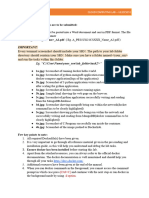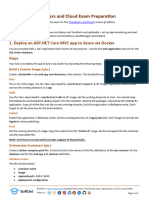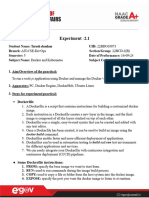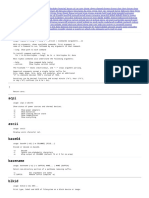COSC 1209 Assignment 1 (Docker File)
Uploaded by
kprincityCOSC 1209 Assignment 1 (Docker File)
Uploaded by
kprincityCOSC 1209 Assignment 1:
Containers
This assignment will cover the creation and deployment of docker containers using dockerfiles and
docker compose. A simple node.js application will be provided to you that you will convert to a
containerized application.
Part 1
Create a dockerfile with the following specifications, include a screenshot in your submission showing
your file. All commands should be part of your dockerfile.
1. Use the node:19.7.0-alpine base image. (1 mark)
2. Set the environment variable NODE_ENV with a value of production.
3. Create a new directory in root called labone (1 mark)
a. Change the ownership to the node user and node group.
b. Set this new folder as the working directory.
4. Set the user to node. (1 mark)
5. Copy all source files and change the file ownership to the node user and node group. (1 mark)
6. Run the npm install command to install your node.js packages (1 mark)
7. Expose port 3000. (1 mark)
8. Set the default execution command to node src/index.js (1 marks)
Run the docker container using docker compose up --build -d Include a screenshot of your container
running on localhost:3000, add your student ID and your name as items. (3 marks)
You can stop your docker container with the docker compose down command.
Part 2
Now that you have established a basic containerized application, the next step will be creating a
database that will allow your data to persist when the container restarts.
In the docker compose.yaml file create a new service called db that uses the postgres image. Add the
following configuration to this service, include a screenshot in your submission showing your file.
1. Set the user to postgres (1 mark).
2. Create a volume called db-data and set the path to var/lib/postgresql/data (1 mark)
3. Set the POSTGRES_DB environment variable to labonedb and set the POSTGRES_PASSWORD
variable to your first name followed by your student number. (1 mark)
4. Expose port 5432 (1 mark)
5. Set a health check with an interval of 10 seconds a timeout of five seconds and five retries. For
the test itself use [ "CMD", "pg_isready" ] (2 marks)
Update the server service with the following configuration:
6. Set environment variables for the POSTGRES_HOST, POSTGRES_USER, POSTGRES_PASSWORD,
and POSTGRES_DB. (1 mark)
7. Add a dependency that is conditional on the db server being healthy. (3 marks)
Add a new volume to the compose.yaml file called db-data. (1 mark)
Start your application using docker compose up --build -d. Provide a screenshot showing a list of all
running docker containers. (4 marks)
You might also like
- Lab 3_ Using Docker Compose for Multi-Container ApplicationsNo ratings yetLab 3_ Using Docker Compose for Multi-Container Applications5 pages
- Develop Intelligence - Docker Docker ComposeNo ratings yetDevelop Intelligence - Docker Docker Compose6 pages
- Docker Scenario Based Questions and AnswersNo ratings yetDocker Scenario Based Questions and Answers25 pages
- 2017 07 07 Rails On Docker Getting Started Docker Ruby RailsNo ratings yet2017 07 07 Rails On Docker Getting Started Docker Ruby Rails23 pages
- I Have A Simple Web Project in React, Node Js And...No ratings yetI Have A Simple Web Project in React, Node Js And...3 pages
- 3-docker for spring boot developer sept 24No ratings yet3-docker for spring boot developer sept 2421 pages
- How To Debug and Fix Common Docker IssuesNo ratings yetHow To Debug and Fix Common Docker Issues17 pages
- Docker Real World Scenarios with SolutionsNo ratings yetDocker Real World Scenarios with Solutions32 pages
- Week4-Lesson2-TheDockerBook-Chapter-OrchestrationNo ratings yetWeek4-Lesson2-TheDockerBook-Chapter-Orchestration69 pages
- 5. Docker Orchestration tools- Kubernetes, Docker SwarmNo ratings yet5. Docker Orchestration tools- Kubernetes, Docker Swarm5 pages
- PSA_AzureDevops_Pipeline_SnowFlake_IDMC (1) - Copy - CopyNo ratings yetPSA_AzureDevops_Pipeline_SnowFlake_IDMC (1) - Copy - Copy9 pages
- Deploying multiple Docker containers to AWS Elastic Beanstalk with CI_CD using AWS CodePipeline and AWS ECRNo ratings yetDeploying multiple Docker containers to AWS Elastic Beanstalk with CI_CD using AWS CodePipeline and AWS ECR23 pages
- Docker_compose_creating_multi-container_servicesapplications_with_Docker.No ratings yetDocker_compose_creating_multi-container_servicesapplications_with_Docker.5 pages
- DevOps Shack _ 10 Docker Projects to Master DockerNo ratings yetDevOps Shack _ 10 Docker Projects to Master Docker43 pages
- DevOps. How to build pipelines with Jenkins, Docker container, AWS ECS, JDK 11, git and maven 3?From EverandDevOps. How to build pipelines with Jenkins, Docker container, AWS ECS, JDK 11, git and maven 3?No ratings yet
- Cache Data Size: 32 Kib Cache Block Size: 2 Words Cache Access Time: 1 CycleNo ratings yetCache Data Size: 32 Kib Cache Block Size: 2 Words Cache Access Time: 1 Cycle2 pages
- KDSSG Center For Excellence: SQL Server 2005 DBA Installation ChecklistNo ratings yetKDSSG Center For Excellence: SQL Server 2005 DBA Installation Checklist5 pages
- How To Install Native Instruments Download Products (PC)No ratings yetHow To Install Native Instruments Download Products (PC)2 pages
- Full download Using Asyncio in Python 3 Caleb Hattingh pdf docx100% (1)Full download Using Asyncio in Python 3 Caleb Hattingh pdf docx55 pages
- Bugreport Alioth - Id RKQ1.200826.002 2022 06 20 21 15 13 Dumpstate - Log 9162No ratings yetBugreport Alioth - Id RKQ1.200826.002 2022 06 20 21 15 13 Dumpstate - Log 916234 pages
- Requirements:: 3. Type The Following Command To Open Diskpart and Press EnterNo ratings yetRequirements:: 3. Type The Following Command To Open Diskpart and Press Enter5 pages
- AUJ A New Proposed Hybrid Page Replacement Algorithm HPRA in Real Time Systems.No ratings yetAUJ A New Proposed Hybrid Page Replacement Algorithm HPRA in Real Time Systems.6 pages
- FIBOCOM SU806 Series Building Development Environment Guide - V1.0.0No ratings yetFIBOCOM SU806 Series Building Development Environment Guide - V1.0.08 pages
- Backup Cluster Configuration: Task Details Commands DescriptionNo ratings yetBackup Cluster Configuration: Task Details Commands Description4 pages
- Google File System and Hadoop Distributed File System-An AnalogyNo ratings yetGoogle File System and Hadoop Distributed File System-An Analogy11 pages
- Flash BIOS by UEFI BIOS Setup Utility enNo ratings yetFlash BIOS by UEFI BIOS Setup Utility en8 pages
- D2 - Launching Feedback-Driven Fuzzing On TrustZone TEE - Andrey AkimovNo ratings yetD2 - Launching Feedback-Driven Fuzzing On TrustZone TEE - Andrey Akimov61 pages

























































































